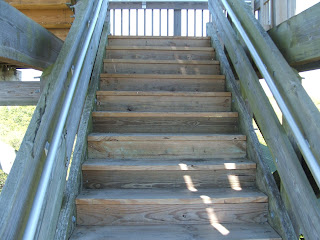Some trails lead to specific sites or vistas. If there is a very specific place hikers want to see, there should be a trail going there. A waterfall, Indian Mound, old homestead, or bird viewing blind are examples of specific destinations.
There was no "Official" trail to this view, but there was a volunteer path to it, interrupted by the sign below. For twice the price of the sign, a boardwalk could have been put in to avoid damage to the mangrove root, and an ugly, rude sign would not have been needed.
If a designated trail does not go where people want to go, odds are that an unofficial trail will pop up anyway.
If there is a trail that takes a circuitous route to that site, a map should be posted showing the trail route. To prevent volunteer trails, or braiding of trails, managers often use boardwalks with waist high handrails to keep people on the designated route. Signs and fencing are less friendly ways to keep people on trails, but are less expensive alternatives to a boardwalk.
When designing the trail routing, it is important to keep sight distances at 100 feet or less to draw the hikers view, and attention to the near field. Gentle curves and turns keep the user focused on the views and not the trail ahead. The one exception is a fitness trail, that needs long straight sections for runners and bicyclists. This lets the runners and cyclist see other users and obstructions with time to avoid collisions or prevent startling surprises.
Putting this exercise path 6 feet further to the right, away from the wave action zone, could have prevented this.. Cutting back the mangroves to "Improve" the view als limits the root growth that could have naturally stabilized this area.
Forethought in trail layout can allow a gentler slope, avoid wave action zones, and make approaches to road or stream crossings safer.
Changing the route of a trail, once established, can be difficult. Doing it right the first time saves costs, and is obvious to experienced hikers. Fences, signs, and even tall boardwalks may have trouble re-routing hikers intent on following the "old" path.
Nominated for an "Outstanding Boardwalk" Award from the William Greenfield Center for Environmental Stewardship, Sawgrass Lake Park Boardwalks are wide, well maintained, and ADA Compliant.
Trail width should allow two adult hikes to pass side by side. Boardwalks should allow two wheelchairs to pass side by side. Wider spots on the trail can allow groups to gather, like at a particular view or be used for a rest bench.
In archeological sites, and other sensitive areas, trails are often very narrow. Narrow trails concentrate all the foot traffic into one small tread area.
This often leads to a "Cow Path" effect. Dairy cattle walk one behind the other, and can cut deep into topsoil in a short time. Once established, the cows use the same narrow trampled surface, forming a trough that leads to erosion.
To avoid this, managers often use crushed rock or shell and put logs or landscape timbers on both sides of the trail. This slows or prevent erosion and helps delineate the permissible walking area.
Click a link below, or copy and paste to your browser, to go there!
A little bit of prose, some poetry,
and a song- all about the environment.
http://billyholcoutdoors.blogspot.com/2012/05/whose-garden-was-this.html
A frank discussion about wilderness and
nature.
http://wmgcenter.blogspot.com/2012/05/can-you-find-wilderness.html
Facebook pages about the outdoors.
Outdoor Photography
Hiking Trails, Boardwalks, and outdoor
recreation construction topics
http://willwalkforfun.blogspot.com/


























